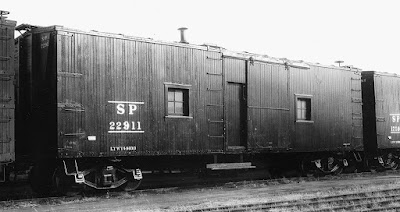In the preceding post of this series, I introduced my first steps on the Shake ’n’ Take project from the 2015 Cocoa Beach meeting and described the background for these projects and Greg Martin’s role. This particular build is a Rock Island 40-foot double-door box car. I showed the first project step, which was to cut out the car ends, as they had to be replaced. That post is at: https://modelingthesp.blogspot.com/2024/09/an-older-shake-n-take-project.html .
With the ends cut out, the car body is pretty floppy, so I immediately made end bulkheads from 0.030-inch styrene sheet, as suggested in the kit directions. (You can obtain these directions if you wish; the original instructions are at: https://groups.io/g/shake-n-take/files/2015%20Shake-n-Take%20RI%20161205%20Auto%20Box%20instrructions.pdf. You must sign up as a member to view and download.) Another option for instructions is the excellent write-up by George Toman on the Resin Car Works site, though George went much farther in detailing than I plan to do. Here is a link to that description: http://blog.resincarworks.com/rock-island-40-foot-automobile-boxcar/ .
The inside corners of the end bulkheads were braced with scale 6 x 8-inch styrene strip, attaching everything with styrene cement. Addition of these restored the car body to a reasonably solid configuration.
I turned my attention at this point to the underframe. I had decided not to pursue adding stringers or cross-bearers in correct location or piping for the brake gear, since that is all essentially invisible in normal operation. But the chain tubes can be seen in a side view, so I added them. Following the kit directions, I used 0.062-inch styrene rod (Evergreen no. 222), drilling holes for them located as shown in the project directions.
Note also in the photo above that I have added styrene strips on the top side (as it will be when installed in the car) to act as gluing surfaces inside the body. The C&BT Shops floor is not a snug fit in the Roundhouse body and will need to be glued. I also added two steel nuts, 5/8-11, which were glued to the floor with canopy glue to weight the model. Here’s a view from above. The chain tube length above the floor, of course, doesn’t matter.
The full set of project parts included a resin piece for the correct-profile side sill reinforcement under the double doors. Since I didn’t have that part, I decided to reconfigure what is on the body that was supplied, then add rivets after the body was primed. Here is a first cut at modifying the side sill. Note I have also removed the molded-on grab irons at this point.
Next I attached the replacement 5/5 ends to the car, using styrene cement. Their contour was adjusted a little along the top of the end to match the contour of the Roundhouse roof. Note also in this view that the holes in the roof have been filled with styrene. The floor is not yet installed. Some of the body’s molded sill steps are still present in this view, but will be replaced later.
With all the heavier work on the body done, the next steps are to add all the correct details. I will describe that work in a future post.
Tony Thompson
















































